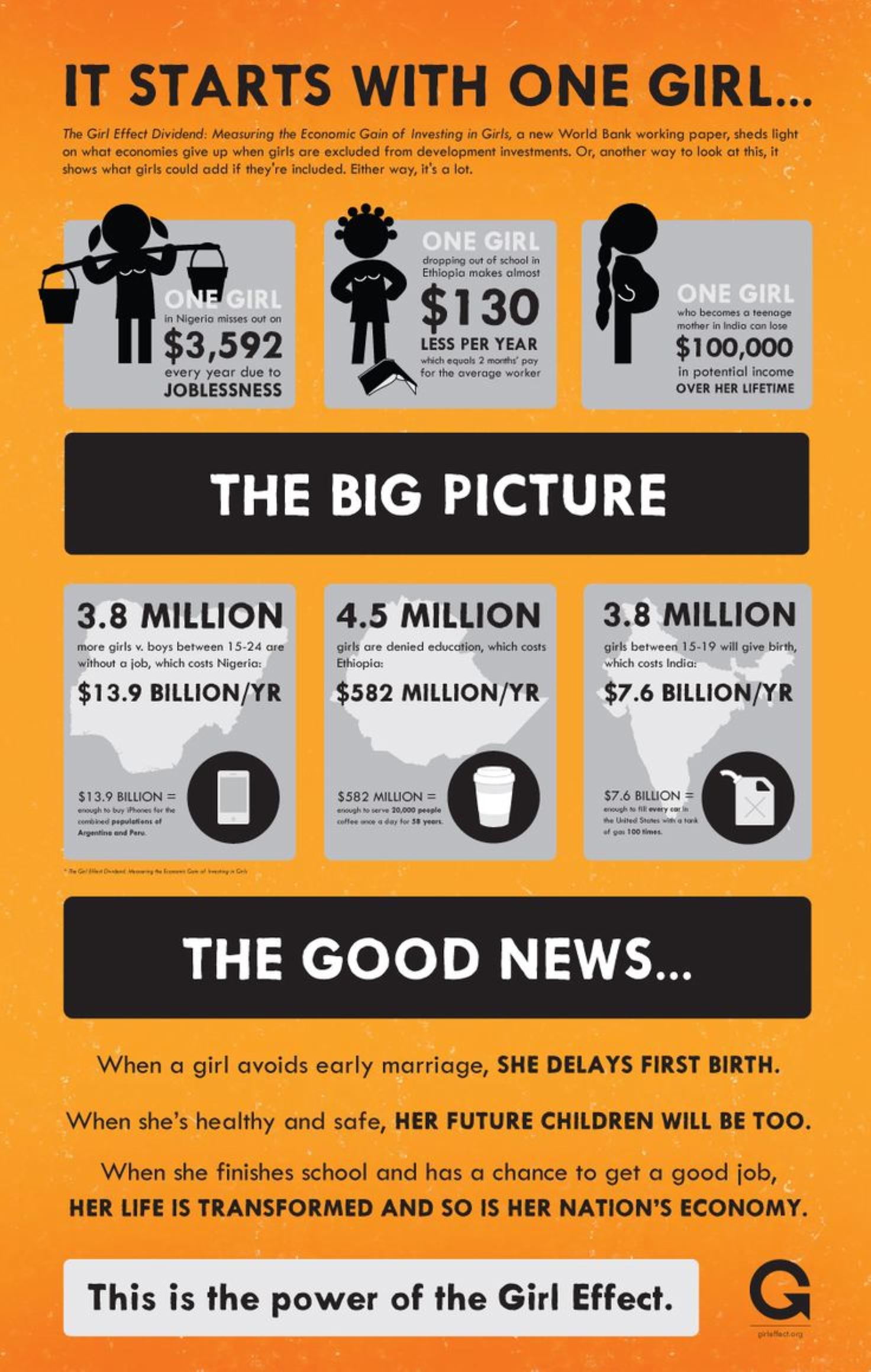Original Ad

The girl effect is an initiative launched by the Nike Foundation in 2008 that epitomizes the idea that economically empowered adolescent girls are the most potent weapon against poverty. They believe there is huge economic gain by investing in girls, and that teen girls have the unique potential to stop poverty before it starts. This advertisement for the movement explains the monetary loss for girls in developing countries from dropping out of school, not having a job, or getting pregnant. They total the amount of monetary losses from all the girls in those developing countries, and then ironically compare that total to things such as iPhones, coffee, and gas. While the girl effect does address critical issues such as reproductive health, child marriage, and access to school, it also causes women and girls to be seen as instruments that generate the highest return on investment within a developmental context. Girls are citizens, not consumers or entrepreneurs. The advertisement tries to frame the inequalities of women as empowerment, however, their “equality” should not rely on business logic. The message doesn’t face the structural problem of gender inequality and power imbalance, rather it masks the structural conditions that perpetuate poverty in Eastern countries. Another problem I saw with this advertisement was the push for girls to act and do as the ‘western, modern, developed side’, which perpetuates the stereotype that these developing countries are backwards, underdeveloped, powerless. Girls lives are being trivialized in this advertisement which gives more agency to Westerners than to the girls it claims to be empowering. It feels like a case of the white saviour complex where they believe they know what is best and refuse to let down their guard of “ultimate liberation” to actually learn from women of colour. Maybe these women don’t need saving. Countries such as Vietnam, Pakistan, Lebanon actually had lower rates of adolescent fertility than the US, and in Rwanda, where the girl-focused interventions are occurring, adolescent fertility is not much higher than the US (Koffman, 2012). It is not clear that the effort to push western policy on these countries will aid them or hurt them.
Jammed Ad

In my jammed version of the ad, I changed 4 things to expose problems surrounding the advertisement, the problem ultimately being the victimization of poor girls in developing countries. The first change I made was removing “It starts with one girl…” for “Eastern girls need saving…” my reason for this, was the entire advertisement girls are depicted as victims to be saved by those with the power to make a difference. Telling them not to have a baby too early, telling them to go get an education, ultimately believing that if we impose our western ideals then we can save them from the ‘poor world’ they live in. The next change I made was adding in a picture of the girls doing different activities and equaling them to westernized materialistic items. The original ad suggests one Easterners life if nothing more than a cup of coffee to a westerner, so that assumption was displayed more upfront in the jammed version. It makes an uncomfortable statement that the lives of these girls are not truly worth as much as someone from a developed, western country. We are taught to pity the women, those other women, living in other places, who do not enjoy the same rights that we do. The third thing I changed was the statement of “the gender gap is fixed, and her nation’s economy is saved.” The advertisement seems to prioritize the well-being of the economy over the well-being of women. Gender equality is being pursued only as a by-product of developmental strategies. Simply Investing in girls does not take into account larger gender issues that occur and could arise, such as domestic violence, rape, the wage gap and many other systemic problems. The last thing I changed was the bottom statement “This is the power of the Western Effect.” I believe this sums up the jammed ad well by reiterating the notion that western people and corporations know best, with the assumption that women programs in developing countries are not designed for them and don’t reflect their needs. It sends a clear message, we are more enlightened, more rational, more civilized and other cultures need to strive to be more like us.
References
Hickel, J. (2014). The ‘girl effect’: liberalism, empowerment and the contradictions of development. Third World Quarterly, 35(8), 1355-1373
Koffman, O. 2012. Will the ‘girl effect’ really help combat poverty? The Guardian, Global Developments – Poverty Matters Blog. https://www.theguardian.com/global-development/poverty-matters/2012/feb/10/will-girl-effect-combat-poverty